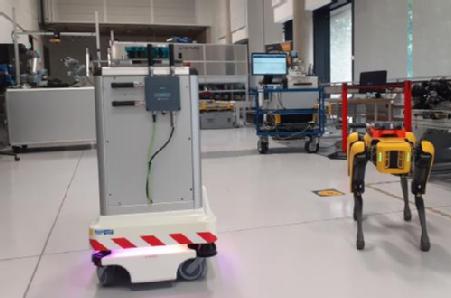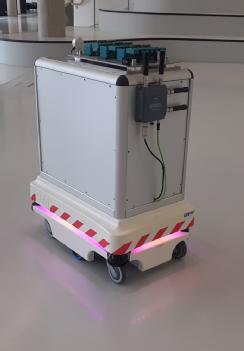WMG Insights
WMG uses 5G autonomous robots to show smart and flexible manufacturing processes
Dr Daniel S. Fowler, Research Fellow; Dr Tony Mo, Project Engineer; Alex Evans, Lead Engineer
New technology generation
Most people have heard of 5G as a topic related to their smartphones. 5G is the current communications technology being rolled out around the world to bring smartphone users fast connectivity and Internet access. This is known as Enhanced Mobile Broadband, a.k.a. eMBB, to support rich multimedia, fast data services, and high-density events (e.g., festivals, trade shows, and sporting events). Yet, when 5G was designed the smartphone user was not the only consideration.
The engineers and designers of 5G wanted to help machine-to-machine (m2m) communication to enable new advanced systems and support the Internet of Things (IoT). 5G is engineered with the capabilities of Ultra-Reliable and Low Latency Communications (URLLC) and Massive Machine Type Communications (mMTC). Meaning it can accurately reduce the delay between sending and receiving information and make large data transfer more efficient. These capabilities can be deployed in private 5G networks that enable novel system designs for different domains including medical, power grids, smart cities, transportation, and industry.
To understand, test, and use 5G’s capabilities within the industrial domain WMG has built a 5G testbed, a practical research platform to use 5G with smart manufacturing and flexible production systems.
Why do we need it?
There are recent global supply chain disruptions from a pandemic, natural disasters, war, localised civil unrest, or simply a container ship stuck in the Suez Canal. Inflexible manufacturing processes reliant on a few suppliers around the world will lower a manufacturer's resilience and the resilience of a country's industrial output. With 5G technology manufacturers can increase their supply chain insights and add flexibility and resilience to output. Existing factory processes can be retrofitted with new data sensors supported by the capabilities of 5G communications to provide access to real-time data analytics. This opens additional opportunities in the modelling of production processes within Digital Twins (DTs), which are highly accurate simulations of systems. DTs are seen as a way of gaining deep insights into factory production to help with optimisation. However, they require access to high volume and timely data, which 5G supports. Then DTs can run what-if scenarios and model different process configurations before the need to commit to a decision or financial expenditure.
How does it work?

5G’s high data density, low latency, and reliable wireless communications can free production machines and lines from the need to be designed as fixed and inflexible systems. Untethered machines, robots, and vehicles allow novel designs for factory systems. Reconfigurable clusters of machines enable greater customisation of products and faster reconfiguration of production for product variations. Production processes connected over 5G to supply chains and logistics, with support from additive manufacturing (a.k.a. 3D printing), will allow customers to order bespoke designs online and follow the manufacturing of their order from raw material to delivery. Cobots (robots working alongside human operators) can be mobile, bringing parts to workers at their stations. Automated Guide Vehicles (AGVs) supported with Artificial Intelligence (AI) can move parts around the factory to reduce worker movement. Technicians can be freed from unnecessary visits using Automated Mobile Robots (AMRs) with high-definition cameras for machine and parts inspection. Teleoperation of AGVs, AMRs, and machinery can aid workers to operate and support multiple sites from a single location, including home working, useful for recruiting operatives who seek a good work-life balance.
Does it mean new machinery?
Some factories still operate machinery that is decades old. It can be a significant capital expenditure to replace an existing specialised machine with a modern “connected” version. Yet, replacement is not necessary as the machine still performs its function. Alternatively, the venerable machine can be fitted with sensors to extract useful data insights and remove manual output inspection. The use of sensor networks, i.e., the Industrial Internet of Things (IIoT), requires fast and reliable communications. 5G can aid in implementing the benefits of Big Data analytics for industrial processes. Deeper insights into power consumption, cycle times, material consumption, wastage, operator movement, and throughput can improve efficiencies and cut costs. These incremental improvements help the resilience of supply chains and will contribute to sustainability goals.
Other possibilities?
Improved access to data and sensor networks via IIoT increases the potential applications of Machine Learning (ML) to support production processes. ML is today’s common way of applying AI to automate data processing and vision recognition. ML can be used to optimise multivariable control processes. It can be used to implement predictive maintenance of machinery. Vibration and sound sensors can pick up minute performance changes that feed ML models to spot when a machine will need maintenance. The same techniques can be used to improve output quality and sensor data can be processed close to the machine using at-the-edge computing. Alternatively, the URLLC abilities of 5G can enable applications in Mobile Edge Computing (MEC), a.k.a. Multi-access Edge Computing. MEC is where data can be sent to high-powered cloud computers for processing and control signals sent back to the machine.
WMG’s advancements
WMG has brought together its expertise in communications, manufacturing, and cybersecurity technologies to build a 5G testbed based on AGVs and AMRs. Any connected system is a potential target for a cyber attack, and that is why cybersecurity resilience is part of the testbed’s aim. The testbed will be used to research 5G capabilities in the manufacturing space to ensure the practical knowledge required to implement reliable and useful 5G connected factory systems is available to interested organisations. The testbed is not limited to 5G, the recent WiFi 6 standard is of interest to manufacturers as a wireless solution. The testbed will be used to test the capabilities of WiFi 6 technologies, ensuring manufacturers use the best wireless communications for their use cases.
Thanks to all who contributed to the 5G Connectivity and Communications Technologies (CCT) testbed project. It is supported by the High Value Manufacturing Catapult and has links to other manufacturing research centres, including the University of Sheffield’s Advanced Manufacturing Research Centre (AMRC) and the National Manufacturing Institute of Scotland (NMIS). The WMG AMR 5G testbed will support any manufacturing organisation or SME who is interested in using 5G to improve and support their manufacturing needs.
How to get involved?
Talk to us today about using the WMG AMR 5G testbed. We can provide tours and demonstrations of our work and facilities to show you how we can support your business or research. We have various funding opportunities and programmes to get involved with.
Contact: wmgbusiness@warwick.ac.uk

